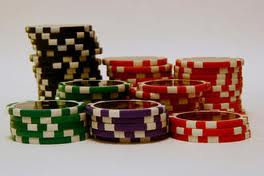Playing Three Flushes in Seven Card Stud
 Seeing as how a flush is one of the top hands in seven card stud, being dealt a three-flush on third street can certainly put you in an advantageous situation. However, not all three-flushes are created equally because some are excellent starting hands, while others offer little value at all. In order to distinguish playable and non-playable three-flushes on third street, let’s take a deeper look at this concept, beginning with the actual definition of a three-flush.
Seeing as how a flush is one of the top hands in seven card stud, being dealt a three-flush on third street can certainly put you in an advantageous situation. However, not all three-flushes are created equally because some are excellent starting hands, while others offer little value at all. In order to distinguish playable and non-playable three-flushes on third street, let’s take a deeper look at this concept, beginning with the actual definition of a three-flush.
What is a Three-Flush?
For beginners who are unfamiliar with a three-flush, this simply refers to being dealt three suited cards right away on third street. The nice thing about this hand is that it greatly improves your chances of getting a flush by the time you’ve got seven cards.
Factors to consider when playing a Three-Flush
There are usually a myriad of factors to consider after being dealt a three-flush in stud games. But in order to cut down on the confusion, here are the main things that you should be considering on third street:
1. If your hand is “live” or “dead”
2. If you have any overcards
3. What your table position is
4. What your door card (first upcard) is
Seeing as how there are several factors to consider here, you have a lot to think about with three-flushes. That said, let’s go in-depth on each one of these aspects and what your thought process could potentially be.
Is your Hand Live or Dead?
One important factor to consider on third street in any stud game is if your hand is live or dead. Going further, a live hand is one where few – if any – of your outs are exposed in opponents’ door cards. Dead hands are the opposite because many of your outs will be shown in opponents’ upcards.
Obviously, the more live your hand is, the more likely you should play your stud cards. In the case of a three-flush, the ideal situation would be if the remaining 10 suited cards were still live. If three or more of your suited cards are among other players’ door cards, you should almost always fold (assuming you don’t have a two-straight or high overcards).
Number of Overcards
Another big thing to consider in stud games when you’ve got a three-flush is how many overcards you have. For example, if your stud cards include As-Qs-Js(upcard), this hand has great potential beyond just the three-flush. However, if you have 9s-7s-2s, this hand has much less value in a stud game.
Stud games are just like any other form of poker in that table position is extremely important. And if you’re holding a three-flush on third street in a stud game, being in late position (closest to the button) is ideal. After all, this gives you a chance to gather more information on opponents and determine their hand strength. Furthermore, you can decide whether your three-flush is worth playing based on any raising that’s happened before.
Your Door Card
The last of our aforementioned factors to consider with three-flushes in seven card involves your door card. The reason why this is so important is because it represents your hand to other players. Assuming you have Ac-Kc and a door card of 3c, this would give you an excellent opportunity to represent yourself as weak – even though your three-flush is strong overall.
Now let’s say that you have 5c-2c and a door card of Ac; here, your ONLY hope for the top hand at the end of seven cards is the nut flush. However, the ace door card gives you a strong chance to semi-bluff other players with a raise. And even if you get called, the three-flush hand still gives you some outs.
Putting it Altogether
Your chances of successfully playing three-flushes in a stud game increase dramatically when you can put all four previously discussed factors together. Going further, you need to combine bits and pieces of these variables to see if playing certain three-flush stud cards is profitable.
To illustrate this thought, let’s say that your hand is Kd-Qd-Jd; in this instance; you’re looking good, but let us also assume that three other door cards on the table are diamonds. From a pure flush perspective, you have to be disappointed because three of your 10 outs are gone. However, you also have a three-straight opportunity, and you’ve got three big cards. All in all, this hand will be playable in a lot of stud game situations.
In order to get another perspective on three-flushes in stud games, let’s say that you hold 8c-5c-3c and none of your outs are anybody’s door cards. Here you have a solid shot to get a flush by the time your seven cards are dealt; however, if somebody were to make a big raise and force everybody else to fold, this may no longer be a profitable hand to play. After all, you don’t want to be heads-up with somebody who’s possibly holding a large pair when your stud cards’ values are 8-5-3. The live flush potential is simply not enough to call or reraise in this situation.
Type of Flush
One final point that we’d like to make about playing three-flushes in stud games involves the type of flush you are chasing. Assuming another opponent has one of your outs, you always have to take into account that they could have flush potential. Now the majority of the time, their stud cards won’t add up to a flush, but you still have to be aware of this element.
Long story short, if you’re not chasing the ace-high nut flush in a stud game, you have to be careful when calling or raising for speculative value. For example, if you have 7d-Kd-Td(upcard) and an opponent’s door card is Ad, you have to look at their betting patterns to determine if they could potentially be chasing the nut flush.
As you can see, there are plenty of factors and scenarios to account for when thinking about playing your three-flush on third street. Luckily, the more stud games you play, the better you’ll get at handling these situations.

